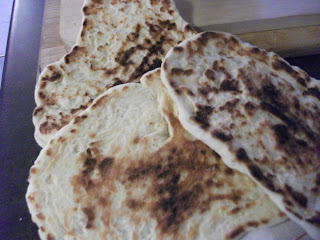That golden yellow
Niter Kibbeh that I made a few days ago has been calling to me from the fridge - I'm big-time craving my favourite Ethiopian dish, Mesir Wat. I make it risotto-style: adding the liquid portion of the recipe in increments until I have the texture that I'm looking for (creamy and more loose than thick). I also find there is enough garlic and ginger flavour from the spiced butter used in the recipe, so I don't add any additional as some recipes do. Regarding the berbere spice mix, I purchase it from an Ethiopian shop -
Blue Nile Restaurant on Gladstone in Ottawa (best shop for purchasing ingredients but my favourite for the dishes is Horn of Africa on Rideau). I've seen berbere recipes that include anywhere from 9 to 15 different spices depending on the source. I like to make my own spice mixes most of the time, but I'm happy to leave this one to the experts.
If you want to make this dish but don't have Niter Kibbeh or berbere spices, you can certainly do so with some modifications, and there are plenty of recipes available elsewhere.
There are a couple of stores in Ottawa that sell Injera (Ethiopian bread), but neither is convenient for me, so I've cooked up a batch of naan instead. Get the naan going first so it has time to rise and can be cooked while starting the lentils. The naan takes about an hour to rise, and about 5-6 minutes each piece to cook, and the lentils take about 45 minutes total - if you start the lentils once you start pan-frying the bread, you'll have the naan all cooked in time for the stew.
Naan Bread
Add a packet (approx. 2 tsp) of yeast into 1 cup lukewarm water; let sit a few minutes to activate (or just use quick rise instant yeast to avoid the hassle).
Beat one egg, then mix with 4 Tbsp white sugar and 2 tsp salt. Stir into yeast/water mixture.
Add 3-4 cups flour (or more) and knead to form a typical bread dough.
Cover in a lightly oiled bowl and let rise in a suitable location for about 1 hour.
Pull off portions slightly larger than a golf ball; roll or stretch flat, no need to worry about shape too much! Cook on medium heat in a dry pan, 2-3 minutes per side. Lower the temperature if it starts getting too hot.
Tip: The dough will puff up a bit during cooking, so best to test a small piece first to get a feel for how thin/thick you like your naan to be. Recipe should make about 8-10 serving size pieces.
Mesir Wat
Warm up 1 1/2 litres of stock (veggie/chicken - your choice). It usually takes around 5 to 5and a 1/2 cups. If you run out before it's the right texture, just add some warm water. It won't dilute the flavour at that point.
Saute 1 finely chopped shallot plus a pinch of salt in 2 Tbsp of Niter Kibbeh in a large pan on medium heat.
Add 1 cup of red lentils, stirring to mix with the butter.
Add 2 Tbsp berbere spice mix. Stir and cook for a minute to ensure the lentils are evenly coated.
Start to add the stock slowly - 1/2 cup at a time; allow the liquid to be fully (or almost fully) absorbed before adding another 1/2 cup. Stir once or twice to incorporate each liquid addition, but no need to constantly stir, it will take care of itself. Add salt to taste.
Serve with a dollop of raita, tzatiki or plain yogurt. Garnish with cilanto or parsley.



















































